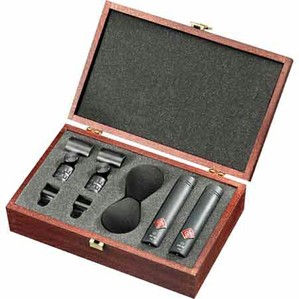High-quality pencil condenser stereo pair

![]()
They’re Neumann. You practically can’t go wrong with Neumann. They provide an incredibly crisp stereo image, and are particularly warm when combined with a tube preamp.
![]()
Like all Neumanns, they’re not cheap. They also start to roll off a little early (around 200 Hz), so they miss out on the kick thump, which is fine if you don’t want that in your room mics. However, it would be much nicer if the 184s had an HPF switch on the side.
![]()
Despite their price, the KM 184s are pretty incredible. They’re low-maintenance, so just set ‘em and forget ‘em. They also have decent off-axis rejection, meaning they don’t take it in the rear (it = sound).
Killer Condensers
Despite their price, the KM 184s are pretty incredible. They’re low-maintenance, so just set ‘em and forget ‘em. They also have decent off-axis rejection, meaning they don’t take it in the rear (it = sound).
Back in the day, drums were treated as a single instrument. All throughout the Gene Krupa era, one or possibly two mics were set up in the general vicinity of the kit, and it was recorded as a whole. The individual drums weren’t independently miked until years later. Modern techniques often place emphasis on miking the kit as a whole for a more “organic” sound, leaving the individual drums lower in the mix. Most bands worth their weight in performance want that whole kit sound, and to get it you better have the right mics watching over you.
Enter the Neumann KM 184. With the full 20 Hz to 20 kHz frequency response, cardioid pickup pattern and awesome off-axis rejection, the 184 guarantees to grab the best of your instrument.
The KM 184 stands on the shoulders of a giant. That giant is the semi-legendary KM 84, widely used through the 1970s. The main improvement is in the frequency curve. The 184 has a soft rise in the 9 kHz range and a roll-off starting around 200 Hz, compared with the 84’s flat response.
The frequency curve of the 184 provides a brighter, livelier representation of sound. This is good for certain things like capturing a piano’s brighter textures and rolling off the mud, but it may leave you fishing for the bottom end of certain timbres.
I have used the KM 184s as a stereo pair over several drum kits. My only problem was an isolated incident with a drummer’s cymbals in the 184s’ tracks. He used a super-bright Paste ride cymbal, and it resonated an ear piercing frequency not noticed until the mixdown. As much as this is a testament to the 184s’ ability to grab sound, it was a laborious process to go back and remove the offensive frequency while preserving the tracks’ naturalness.
If you’re recording in a place with hard walls (i.e. your basement) you have to worry about microphones picking up too much of the room sound. For instance, when you hit a snare, the overhead records the snare hit, then a few milliseconds later, it records the reflection of the snare hitting off the wall or walls. This isn’t a problem for the snare mic, since it’s kept at a certain mix level and can be gated, but your overheads are truly at the mercy of the room and all its anomalies. This is where the Neumann KM 184s outshine many overhead condensers. The 184s have great off-axis sound rejection. They’re not supercardioid, though the pickup pattern kind of resembles a supercardioid’s in the upper frequencies (16 kHz range). They’re just really good when it comes to recording what’s in front of them instead of what’s around them.
The 184s are not strictly for the drums. Although I’ve only used them on kits, timbales, congas, bongos and other percussion, they are widely renowned for recording piano, orchestral instruments (strings and brass), acoustic guitars, and choirs… virtually anything. The sensitivity is low enough to grab the subtleties and overtones, but has a high SPL tolerance for loud transient hits, which is why they’re my choice for timbs.
It ultimately comes down to the sound (performance and tone) for which you’re going for. If your song calls for a mellow tone, you can use the KM 184 on any of these instruments, but you may end up attenuating the upper end in production. Personally, I wouldn’t use the 184 on any amp because I have other mic preferences and techniques to accurately capture amp tone.
Technical Info:
Acoustical operating principle: Pressure/Pressure gradient transducer
Directional pattern: omnidirectional/cardioid/hypercardioid*
Frequency range: 20 Hz – 20 kHz
Sensitivity at 1 kHz into 1 kohm: 12/15/10 mV/Pa*
Rated impedance: 50 ohms
Rated load impedance: 1000 ohms
S/N ratio CCIR 468-3: 70/72/70 dB*
S/N ratio DIN/IEC 651: 81/81/79 dB*
Maximum SPL for THD 0.5%: 140/138/142 dB*
Maximum output voltage: 10 dBu
Supply voltage: 48 V ± 4 V (standard phantom power)
Current consumption: 3.2 mA
Matching connectors: XLR 3F
Weight: approx. 80 g
Diameter: 22 mm
Length: 107 mm
Price: $800 or $1650 for matched pair
Be sure to check out the other Microphone Reviews
Were to Buy:

Speak Your Mind